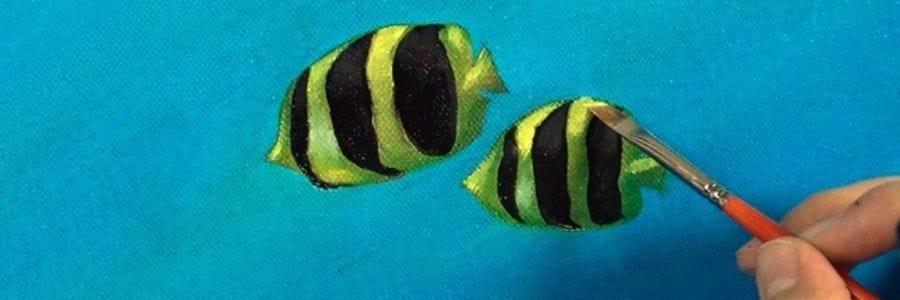Creating an underwater seascape painting has it’s own set of challenges. Before you get started, here are some of our top tips for achieving the right perspective, composition and effects.
1. Build Your Background

Even though it’s not at the forefront, it’s important to get the background of your seascape painting right. Give your background depth and sparkle by first tinting the canvas with a pearl or silver, waiting for it to dry, and then glazing a translucent colour on top of it.
2. Paint Underwater Perspective
Water acts like a filter and effects the way colours look. To get your underwater perspective right, remember that the closer the element is to the viewer, the clearer it is. Use softer tones for elements that are in the distance. You can achieve this effect by tinting the colours you’re using for your background elements with the tone you have used to paint the water.
3. Create Realistic Underwater Colour
Water changes the appearance of colour. To make your seascape painting look more realistic, give your elements a blue grey tint. You can do this by adding a touch of Zinc White and Ultramarine to the colours you use for your fish or sea plants for example.
4. Underwater Light
The deeper you go in the ocean, the darker the colour of the water. Gradually transitioning the colours from light to dark as you move down will help create the effect of depth in your seascape painting. For a smooth transition, add a little white to the colour you’re using at the top of your seascape painting and, as you bring it down through the middle-ground, use less white and start to add darker tones towards the bottom.
5. Blending
To smoothly blend your background colours, use horizontal brush strokes and a small spray of water if you’re using acrylics and they start to dry out.
6. Build Detail

The ocean can be a busy environment, so don’t forget to add fish and other elements to the background. Use our depth and perspective tips above as a guide.
7. Translucent Elements
Use glazes to create translucent fins and rays of light breaking through the water’s surface. A glaze is when a translucent colour is laid over a dry base colour. In this scenario you may like to mix a touch of white with a medium to make it translucent and use it for fins or rays of light.
8. Light Effects
To depict light passing through the water and onto sea creatures or plants, use a fine brush of filbert to add the appearance of shine. The stronger the light, the more white you’ll want to add to your colours.
9. Don’t Get Caught up on Symmetry
Don’t make your seascape painting too symmetrical. If you’re placing fish in the background, remember to place them at different angles and proximities to one another. This will make your painting look more natural instead of being staged.
10. Think Outside the Box
Transfer different textures and effects onto your seascape painting by using cling film or sponges. Don’t be shy, tag us on Instagram and Facebook with #montmarteart to show off your masterpiece. We’d love to see your beautiful seascape painting.
If you need some creative inspiration, watch our video tutorial on how to paint a Lion Fish.





























